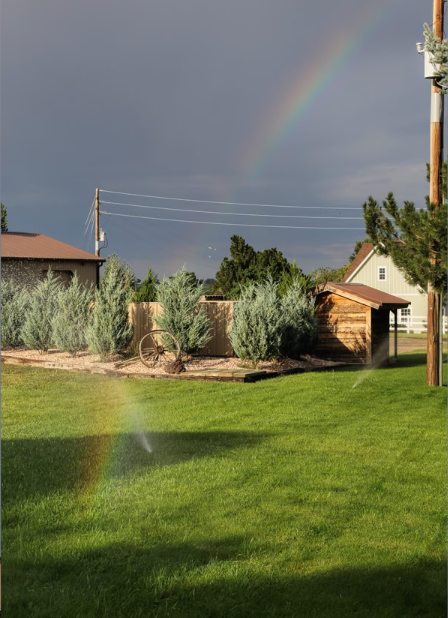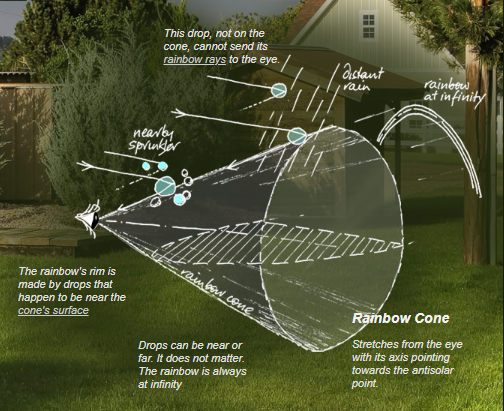Rainbows Near & Far - OPOD
Rainbows Near & Far: A Closer Look at the Illusion of Distance
Rainbows have long fascinated us with their vibrant colors and ethereal beauty. They often appear as if they are within reach, yet they remain forever elusive. In this article, we will delve deeper into the concept of "near" and "far" rainbows, exploring the misconceptions surrounding their distance and shedding light on the optical illusion that captivates our senses.
The Illusion of Distance
Contrary to popular belief, rainbows cannot be close or distant in the conventional sense. Rather, it is the water droplets that create the rainbow that can be found at varying distances. However, regardless of the distance, if the water droplets are of the same size, the rainbow will always appear the same – as though it is infinitely far away. It is an illusion that defies our perception and entices us with its elusive nature.
Rainbows in the Spray
Imagine standing in a garden, where a sprinkler gracefully showers water droplets into the air. If you happen to spot a rainbow in the spray, you may be perplexed by its appearance. The rainbow in the spray seems tangible, almost within reach, while the one in the sky appears distant. However, both rainbows are equally distant – far away at infinity. It is our perception that deceives us, making one seem closer and more tangible than the other.
The Broadening Effect
Interestingly, the rainbow in the spray from the sprinkler may appear slightly broader than the one in the sky. This phenomenon is not due to the proximity of the water droplets in the spray, but rather their size. Smaller water droplets result in broader rainbows. So, while it may seem as though the sprinkler bow is closer due to its width, it is merely an optical illusion caused by the size of the water droplets.
The Unreachable Ends
As we gaze upon a rainbow, we are often captivated by the allure of the "pot of gold" at its ends. However, no matter how far we walk or how fast we drive, the ends of the rainbow will always remain beyond our reach. This is because the rainbow moves with us, mirroring our movements and forever eluding our grasp. It is a symbol of beauty and wonder that can never be touched or possessed.
Exploring the Science
To understand the mechanics behind rainbows, we must delve into the science of optics. Rainbows occur when sunlight is refracted, or bent, as it enters water droplets suspended in the air. This bending of light causes the different colors of the spectrum to separate and form a circular arc of colors. The angle at which light is bent determines the size and position of the rainbow. It is this intricate interplay of light and water droplets that creates the mesmerizing phenomenon we know as a rainbow.
A Multitude of Rainbows
While we commonly associate rainbows with rain showers, they can actually form in various other conditions as well. Some lesser-known types of rainbows include:
- Moonbows: Rainbows that occur at night when moonlight is refracted by water droplets.
- Fogbows: Rainbows that form in foggy conditions where tiny water droplets scatter light.
- Supernumerary Rainbows: Additional, fainter rainbows that appear inside the primary rainbow due to interference between light waves.
Each type of rainbow offers its own unique beauty and serves as a testament to the intricacies of nature's optical wonders.
The Magic Persists
Even with a deeper understanding of the science behind rainbows, their enchantment remains intact. The illusion of distance, the unattainable ends, and the ever-changing nature of these colorful arcs continue to inspire awe and wonder. Rainbows remind us of the vast complexity of the natural world and the captivating mysteries that lie just beyond our grasp.
So, the next time you catch a glimpse of a rainbow, take a moment to appreciate its elusive beauty. Embrace the illusion of distance and allow yourself to be captivated by the magic that unfolds before your eyes.

"Near" & "Far" Rainbows
Dan Bennett of Windsor, Colorado spotted this rainbow simultaneously in the sky and in the spray of a lawn sprinkler.
©Dan Bennett, shown with permission
Both bows are the same distance away - far away at infinity.
A popular misconception is that rainbows can be close or distant.
The water drops making a rainbow can be at any distance - or two distances as here - but provided the drops are the same size the rainbow always looks the same. It looks and behaves as though it is at infinity. It cannot be touched, tickled, walked around or driven through. It moves as you move and is forever unapproachable. The bags of gold at its ends are forever beyond reach.

This sprinkler bow is in fact slightly broader than the bow in the sky. Nothing to do with the sprinkler drops being closer but everything to do with them being smaller. Smaller drops give increasingly broader rainbows.
Note: this article has been automatically converted from the old site and may not appear as intended. You can find the original article here.
Reference Atmospheric Optics
If you use any of the definitions, information, or data presented on Atmospheric Optics, please copy the link or reference below to properly credit us as the reference source. Thank you!
-
<a href="https://atoptics.co.uk/blog/rainbows-near-far-opod/">Rainbows Near & Far - OPOD</a>
-
"Rainbows Near & Far - OPOD". Atmospheric Optics. Accessed on April 20, 2024. https://atoptics.co.uk/blog/rainbows-near-far-opod/.
-
"Rainbows Near & Far - OPOD". Atmospheric Optics, https://atoptics.co.uk/blog/rainbows-near-far-opod/. Accessed 20 April, 2024
-
Rainbows Near & Far - OPOD. Atmospheric Optics. Retrieved from https://atoptics.co.uk/blog/rainbows-near-far-opod/.